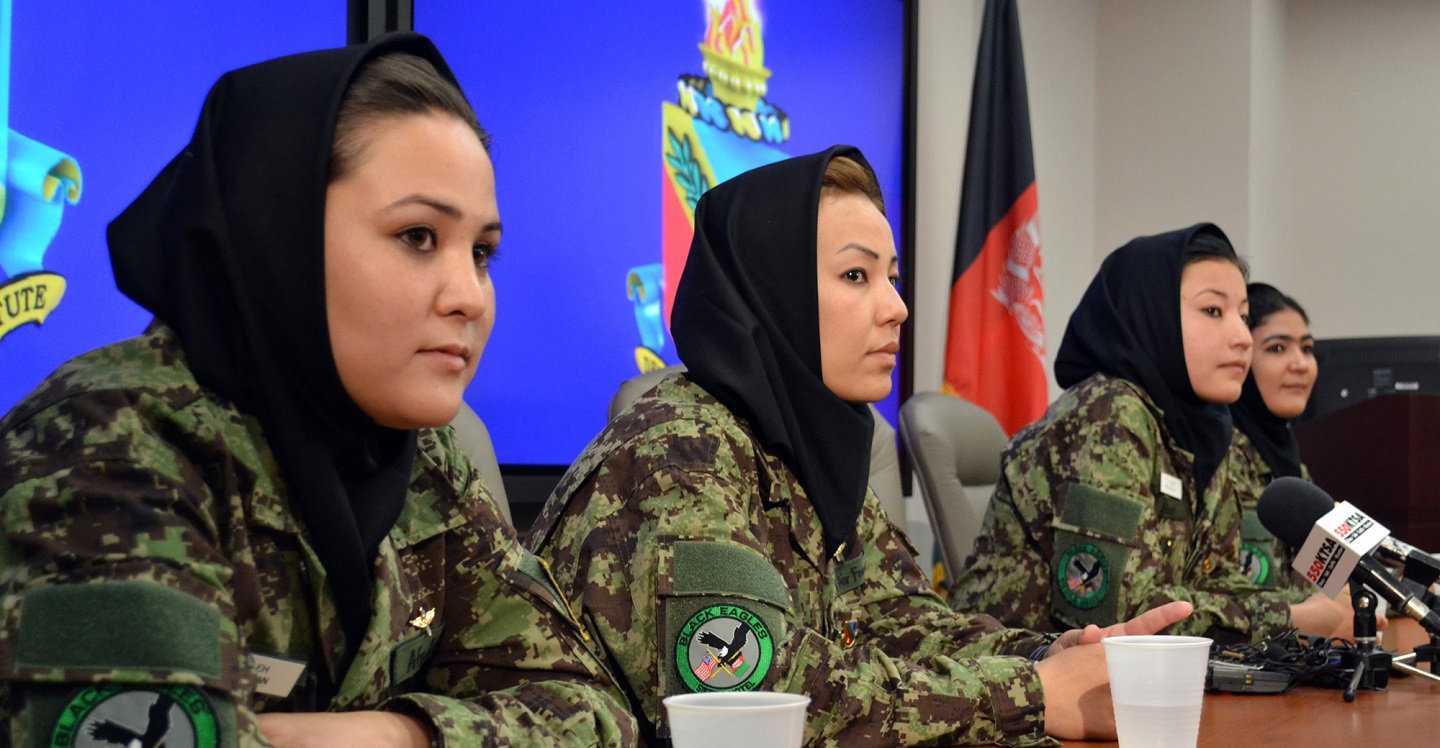
If you are neutral in situations of injustice, you have chosen the side of the oppressor. If an elephant has its foot on the tail of a mouse, and you say that you are neutral, the mouse will not appreciate your neutrality.
― Desmond Tutu
In November 2001, just one month after the United States began combat operations in Afghanistan, the United Nations Security Council passed Resolution 1378. Resolution 1378 reaffirmed earlier United Nations calls for a settlement, specifically identifying gender equality as a required cornerstone of peace in Afghanistan. This year, as peace negotiations with the Taliban progressed in earnest, the Security Council passed Resolution 2513, reaffirming the need for women to be active participants in the process. Indeed, promoting women’s rights has been used as a continued justification for U.S. military presence, to include mandating the inclusion of women in Afghan peace negotiations in the National Defense Authorization Act (NDAA) and the Department of Defense’s guidance on the implementation of the 2017 Women, Peace and Security (WPS) Act. However, despite this clear focus on women and women’s rights, the most recent peace agreement between the United States and the Taliban fails to meaningfully include women in process and outcome, and current negotiations between the United States and the Taliban leave women behind. This failure is particularly stark given the backdrop of the 20th Anniversary of UN Resolution 1325, and the codification of the support of Afghan women in both a standalone WPS policy and the NDAA.
The failure of the United States to ensure that Afghan women meaningfully participate in the final peace negotiations highlights the challenges of adopting a robust WPS strategy. For two decades, the United States has embarked on a top-down codification of WPS, with Afghanistan poised to be a successful case study. However, mid-level implementation of this strategy has been ad hoc, coupled with a lack of institutional understanding of why WPS matters for security. The result is continued neglect of what have historically been seen as “women’s issues” and the exclusion of women from decision-making processes and positions. Events in Afghanistan highlight how hard it is to change tactical- and strategic-level thinking, creating a very real challenge for establishing or maintaining security. Without the purposeful, direct inclusion of Afghan women from civil society, government, and defense and security sectors in the peace process in Afghanistan, security will likely remain elusive.
The United States’ involvement in Afghanistan was a critical test for the American commitment to WPS, and the failure to meaningfully include women in the settlement suggests the United States still has not fully understood or embraced the program of work required to address the national security components inherent in WPS or the importance of addressing the specific needs of women and girls. Using the framework laid out by the objectives in the Department of Defense’s implementation guidance for the 2017 WPS Act, it is clear that a lack of mid-level support and a lack of comprehensive understanding of WPS principles ultimately led to Afghan women being left behind.
The U.S. and Afghanistan Conflict through a Women, Peace and Security Lens
In the initial decade of the conflict, it appeared that Afghanistan would be a test case for the successful application of WPS as women’s rights became a rallying cry for U.S. intervention in Afghanistan. In a November 2001 radio address, then-First Lady Laura Bush stated, “The brutal oppression of women is a central goal of the terrorists.” Out of this address, the U.S.-Afghan Women’s Council was born. In 2012 at the Council’s 10th Anniversary celebration, then-Secretary of State Hillary Clinton stated that the United States will not support a peace deal that excludes women or rolls back hard-won rights. A bipartisan group of Congresswomen further asserted that the inclusion and success of women would be the yardstick by which success in Afghanistan would be measured. In a 2013 House Armed Services Committee hearing, Congresswoman Niki Tsongas stated, the “safety and security of women in Afghanistan…is an important barometer of the success of [U.S.] efforts.”
The conflict in Afghanistan also motivated the United States to adopt a National Action Plan (NAP). The NAP highlights U.S. involvement in Afghanistan and the importance of empowering local women more than a dozen times. Operationally, the employment of Female Engagement Teams (FET) and Civil Support Teams (CST) were lauded as evidence that the U.S. military understood the strategic importance of integrating women into counterinsurgency strategies.
When combat operations transitioned to the NATO-backed Resolute Support Mission (RSM) in 2015, one of the U.S. National Military Strategy objectives was to ensure meaningful inclusion of women in the security sector. Initial efforts were successful. The first female special forces members, first female pilots, and first all-female flight crews have been celebrated both in Afghanistan and the international press. But in recent years, as the United States has drawn closer to a peace deal with the Taliban, violence against women has increased, and Western focus on women in the security sector has declined.
General officers and policy makers in Washington, D.C. may be well-intentioned, but they are far removed from on-the-ground implementation.
A Cascading Failure to Include Women
What led to this shift away from a focus on women’s rights and security? Given the initial emphasis, the path to implementation of WPS tenets in Afghanistan should have been clear. Yet after 19 years of sustained armed conflict, thousands of deaths, and $137.86 billion appropriated for Afghanistan relief and reconstruction since 2002, U.S.-led efforts to develop an effective, affordable, and sustainable Afghan security force capable of protecting rights, particularly women’s rights, remains questionable.
Though the Department of Defense just introduced its implementation guidance for the 2017 WPS Act this year, the objectives contained in this guidance provide a useful framework for understanding what went wrong. The Department’s implementation guidance consists of three objectives:
Defense Objective 1. The Department of Defense exemplifies a diverse organization that allows for women’s meaningful participation across the development, management, and employment of the Joint Force.
Defense Objective 2. Women in partner nations meaningfully participate and serve at all ranks and in all occupations in defense and security sectors.
Defense Objective 3. Partner nation defense and security sectors ensure women and girls are safe and secure and that their human rights are protected, especially during conflict and crisis.
As two of our authors have noted previously, these objectives are intrinsically interrelated. To effectively engage with partner nations, the military must first fully embrace its internal diversity at all levels. It is not enough to have top-down support. General officers and policy makers in Washington, D.C. may be well-intentioned, but they are far removed from on-the-ground implementation. As one of our authors observed firsthand while serving as a gender advisor in Afghanistan, leaders in-country often dismiss or sideline women’s issues in favor of what they viewed as “hard” security concerns. Gender advisors are routinely excluded from security conversations, and operational leaders often fail to support incorporation of gender perspectives into daily tactical operations.
Further, outside of the gender advisor role, there has been little deliberate focus on WPS by operational-level military leaders. Military planners and senior leaders are not versed in WPS, nor is a robust gendered perspective institutionally applied to strategic planning. While FETs were lauded, they were used primarily on an ad hoc basis – tactically successful but ignored strategically. By isolating WPS from other missions and neglecting it as a collateral duty, the United States effectively removed women’s perspectives from discussions of “serious” security. In other words, despite the top-down commitment to WPS, commanders on the ground did not fully understand or embrace it.
This mid-level failure of the United States to fully implement and integrate WPS within its own forces had a cascading impact on its ability to ensure that Afghanistan as a partner nation was fully committed to WPS. In the 2015 semi-annual Enhancing Security and Stability in Afghanistan report to the U.S. Congress, military leaders stated their commitment to preserving women’s rights and to preserving gains made over the last decade. However, evidence suggests that in the years since the Afghan National Defense and Security Forces (ANDSF) were given the lead in security, the security of women and girls deteriorated. In its quarterly report to U.S. Congress, the Special Inspector General for Afghanistan Reconstruction (SIGAR) reported increased challenges for Afghan women. The Kabul Maternity ward attack in May 2020 illustrates one such challenge. In the June 2020 report to Congress, the DoD reported that ANDSF struggled to recruit, retain and manage the career progression of women. In December 2015, it was reported that the Afghan National Army (ANA) had 780 women and the Afghan National Police (ANP) had 2,200. As of May 2, 2020, the ANA had 1,996 women and ANP had 3,346. While there was slight growth of female recruitment into the ANDSF, it is far short of the targets set forth in the Afghan NAP 1325 and by NATO.
In February 2020, in parallel meetings taking place in Doha, Qatar and Kabul, Afghanistan, the United States signed the latest agreements for bringing peace to Afghanistan. Despite several rounds of negotiations leading to the peace agreement and joint declaration, Afghan women’s rights were not included. Recognizing the U.S. failure to internally implement WPS principles makes it easier to understand the deterioration of women’s participation in the security sector in Afghanistan and their ultimate exclusion from participation in the peace deal. Nonetheless, the failure to secure women’s rights sent shock waves across the ANA, the ANP’s female population, and Afghan women in civil society. While serving as gender advisor, Lt. Col. Natalie Trogus discussed the concerns Afghan women had on the resurgence of the Taliban during her routine engagements with Afghan soldiers and citizens. She learned that, lacking formal protection in the peace agreement, Afghan women now fear that when the United States withdraws, they will be the first ones targeted.
What can be done?
Still, top-down commitment is critical for the successful implementation of WPS. The 2020 NDAA identifies actions to be taken by the Secretary of State and Secretary of Defense to ensure the meaningful participation of Afghan women in the peace process consistent with the WPS Act of 2017. The top-down emphasis on Afghan women being included in ongoing and future negotiations to end the conflict in Afghanistan could not be more clearly stated. Finally, the NDAA presents programs and activities to promote conflict prevention and resolution through the successful and meaningful integration of women into the ANDSF.
However, these top-down objectives will not be met without the necessary buy-in and appropriate understanding of WPS by leaders in the middle ranks as well, specifically field grade officers and staff noncommissioned officers who do the heavy lifting of planning and leading operational units. It is not enough to appropriate funds; the individuals charged with conducting operations on the ground in Afghanistan must have a full understanding of the linkages between the security of women and the security of the state. This starts with ensuring that gendered perspectives are part of the planning process in-country, not by leaders in Washington. This necessitates educating all practitioners – not just gender advisors – on the benefit that women bring to the table. Fully integrating a gendered perspective within the U.S. security sector will lead to more meaningful security assistance for our partner nations. While the appetite to continue engagement in Afghanistan is dwindling, the lessons learned on the importance of mid-level buy-in are essential for the United States to be a leader in future conflicts.
Dr. Kyleanne Hunter, PhD is an Assistant Professor of Military and Strategic Studies at the United States Air Force Academy, a Nonresident Fellow at the Brute Krulak Center for Creativity and Innovation, a Senior Adjunct Fellow at the Center for New American Security and co-Director of the Athena Leadership Project. She is a Marine Corps Combat Veteran.
Dr. Jeannette Gaudry Haynie, PhD, is a retired Marine Corps Reserve Lieutenant Colonel, Senior Adjunct Fellow at the Center for New American Security, co-director of the Athena Leadership Project, and a political scientist at the RAND Corporation.
LtCol Natalie Trogus, USMC, served as the Gender Advisor to the Afghan Ministry of Defense from July 2019 – July 2020. She has been in the Marine Corps for 21 years and has six combat deployments. She is currently a student at the College of International Security Studies (CISA) at the National Defense University (NDU), Washington, D.C.
The views expressed in this article are those of the authors and do not necessarily reflect those of the U.S. Army War College, the U.S. Army, the U.S. Air Force, U.S. Marine Corps, or the Department of Defense.
Photo Description: Four Afghan helicopter pilot candidates attend a press conference July 13, 2011, at the Defense Language Institute English Language Center at Lackland Air Force Base, Texas. The women begin their English language studies at the DLIELC, marking a significant milestone in shaping the reconstruction of Afghanistan. Upon their return to Afghanistan in 2012 they were indefinitely placed on “inactive reserve.” It is unknown if these women are still in the military. Female members of the Afghan military are often resented by their male counterparts as well as targeted by the Taliban.
Photo Credit: U.S. Air Force photo/Staff Sgt. Desiree N. Palacios





I believe that the current changes in decisions relating to such things as fighting for women’s rights — not only in Afghanistan but also here in the United States — I believe that these such changes may be related to President Trump’s (and the conservatives’?) overall “traditionalist” philosophy.
From that perspective, one could easily see how President Trump (and those who think like him) might:
a. Make every effort to overturn “Roe v. Wade” here at home and:
b. Be significantly less concerned with attaining — and/or with preserving — “women’s rights” elsewhere in the world, for example, in places such as Afghanistan.
In addition, a move to be less concerned with attaining — and/or with preserving — such things as “women’s rights” in foreign countries, this might be seen as also being consistent with President Trump’s (and the conservatives’) grand strategic ideas relating to state and societal “sovereignty” and, thus, to the legitimacy of political, economic, social and value difference, diversity and equality?
Specifically as to these such Trumpian/conservative ideas — re: “sovereignty” and political, economic, social and value difference, diversity and equality — consider the following:
“We are also realistic and understand that the American way of life cannot be imposed upon others, nor is it the inevitable culmination of progress.”
(See Page 4 of the Trump National Security Strategy.)
“We do not expect diverse countries to share the same cultures, traditions, or even systems of government. But we do expect all nations to uphold these two core sovereign duties: to respect the interests of their own people and the rights of every other sovereign nation. This is the beautiful vision of this institution, and this is foundation for cooperation and success.
Strong, sovereign nations let diverse countries with different values, different cultures, and different dreams not just coexist, but work side by side on the basis of mutual respect.”
(See about the 15th and 16th paragraph of the White House transcript of the Trump 2017 U.N. General Assembly speech.)
Bottom Line Thought — Based on the Above:
Individuals, groups, governments, etc. — who have a “traditionalist” philosophy and grand strategic ideas which are consistent with same (see “sovereignty” and political, economic, social and value difference, diversity and equality above) — these folks should have no trouble crafting, and/or accepting, an Afghan peace process that marginalizes (or even eliminates) the participation and rights of women. Yes?
In my initial comment above, I suggested that the Trump Administration’s apparent willingness to accept an Afghan peace process — that marginalizes or even eliminates the rights of women — that this such move might be best understood from the standpoint of the Trump Administration’s (and the American conservative’s?) apparent “traditionalist” philosophy and, consistent with same,
a. Their efforts to reverse Roe v. Wade here at home and
c. Their embrace of the concept of “sovereignty” for nations abroad (i.e., the acceptance of the legitimacy of the political, economic, social and value differences of other states and societies).
These such moves, of course, constitute a 180 degree “about face” from the “modernizing”/”further modernizing” efforts that the U.S./the West had been engaged in, both here at home (think re: our domestic policies) and there abroad (think re: our foreign policies), since at least the end of the Old Cold War.
Given these developments, I suggest that we might benefit from now:
a. Looking at these matters from the standpoint of this excerpt from Samuel P. Huntington’s famous 1968 book “Political Order in Changing Societies” (therein, see Page 41) and
b. Determining whether we believe that the U.S. is headed — re: its such “traditionalist” moves today — more in a “good,” or more in a “bad,” direction.
Here is the Huntington excerpt:
“The apparent relationship between poverty and backwardness, on the one hand, and instability and violence, on the other, is a spurious one. It is not the absence of modernity but the efforts to achieve it which produce political disorder. If poor countries appear to be unstable, it is not because they are poor, but because they are trying to become rich. A purely traditional society would be ignorant, poor, and stable.”
Bottom Line Questions — Based on the Above:
Certainly in both the U.S./the West and elsewhere in the world today, we might say that people are experiencing some degree of “political disorder, instability and violence.”
And certainly in both the U.S./the West and elsewhere in the world today, we might say that — as per Huntington above — these such disorders can be traced to:
a. Efforts made by nations to become rich or richer which:
b. Today as in the past requires “modernization” and “further modernization.” (For example, the embrace of such things as “women’s rights?”)
Given this such understanding, should we say that many nation’s moves today — to do a 180 degree “about face” and embrace “traditionalism” instead — that:
a. While the temptation to move in that direction is certainly understandable — given the “political disorder, instability and violence” noted above —
a. It may not be wise — given that competing nations will take advantage of our such “backwards” moves (which amount to trading temporary stability for long-term security?) — to out-pace and out-compete us?
Another possible way of looking at such things as “women’s rights” today — and other “modernization” v. “traditionalism” issues here at home and there abroad — this might be from the perspective of “positional warfare,” for example, as follows:
If the goal (or one of the goals) of “positional warfare” is to:
a. Have the enemy abandon his superior “ground” — to wit: the “ground” that he currently occupies (ex: his “castle”) and, thus, can much more easily defend and much more easily “win” in — and
b. Cause the enemy, instead, to come do battle on one’s own “ground” — “ground” which, thus, (a) eliminates the enemy’s such tremendous advantage and (b) causes him to be exceptionally more vulnerable to attack and defeat,
Then, from this exact such perspective, might we say that:
a. By causing the U.S. to abandon its long-running “modernization” efforts both here at home and there abroad (see my two initial comments above) and
b. Causing the U.S. to embrace “traditionalism” instead (i.e., the “ground” that our enemies currently occupy and “win” in);
By doing this, our opponents today (Russia, China, Iran, N. Korea, the Islamists, etc.) have succeeded (via this aspect of “positional warfare?”) beyond their wildest dreams?
Hi sir LtCol Natalie trogus
I’m Mohammad shoaib esmatty I worked at human right Expert in Department of Human right and intergration Mod Afghanistan with mss Muska karimi Diriqtor
I’m from panjsher province of Afghanistan as you know panjsher people is in Danger very very I want to help me
Sir I’m hiding every day and every I have bad economy too
Thank you
This is my signal and whatts up No 0093729525389